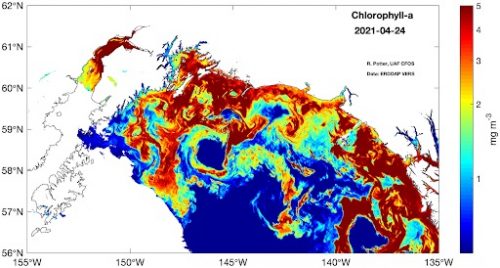NASA awards funding to UAF for ocean research
July 19, 2021

The National Aeronautics and Space Administration has awarded University of Alaska researchers funding for a project that will support NASA’s mission to seek a better understanding of the ocean’s role in the Earth system.
The funding is from the Ocean Biology and Biogeochemistry component of NASA’s Minority University Research and Education Project. As an Alaska Native- and Native Hawaiian-serving institution, the University of Alaska was one of 10 universities to receive a MUREP award.
“A lot of major breakthroughs have happened from our ability to measure the ocean from space. To understand the whole system, you need global data,” said William Burt, the principal investigator of the project who is a faculty member at UAF’s College of Fisheries and Ocean Sciences.
Satellites measure the light emitted from the ocean surface, and the color of the ocean indicates what is in the water. The phytoplankton, or microscopic plants, supporting the ocean ecosystem typically appear green.
Burt and his team, currently funded by the North Pacific Research Board, will use the NASA MUREP funding to compare satellite imagery of phytoplankton with 25 years of ship-based measurements collected in the Gulf of Alaska. The comparison will help scientists better understand how satellites can measure not only the biomass of phytoplankton but also, potentially, its different sizes and species.
The scientists will assess changes in phytoplankton due to climate change and apply this information to fisheries forecasting models.
“The oceans are warming and it has been shown to be linked to a smaller phytoplankton community. That is a less-efficient energy source to feed fish and other higher trophic level animals,” Burt said.
NASA will provide $730,000 for three years of research that supports Burt and CFOS faculty member Curry Cunningham, a postdoctoral researcher at the International Arctic Research Center and graduate student in UAF’s Tamamta program. Tamamta fellows apply both Indigenous and Western knowledge to address key questions in fisheries and ocean sciences.
The project will also provide opportunities for K-12 students to engage with the research. High school students in Burt’s newly launched Students Observing Sikuliaq Satellite Information Program will have the opportunity to conduct matchup analyses between satellite images and real-time bio-optical data from the researchers during annual cruises on the research vessel Sikuliaq.
“NASA makes this info publicly available, it’s a huge resource and a great educational tool that a lot of people aren’t aware of,” Burt said.


